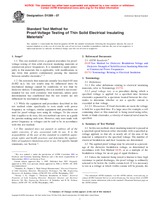Potrebujeme váš súhlas na využitie jednotlivých dát, aby sa vám okrem iného mohli ukazovať informácie týkajúce sa vašich záujmov. Súhlas udelíte kliknutím na tlačidlo „OK“.
ASTM D1389-07
Standard Test Method for Proof-Voltage Testing of Thin Solid Electrical Insulating Materials (Withdrawn 2014)
Automaticky preložený názov:
Štandardná skúšobná metóda pre Proof - napätie testovanie Thin Solid Elektroizolačné materiály ( Withdrawn 2014 )
NORMA vydaná dňa 1.5.2007
Informácie o norme:
Označenie normy: ASTM D1389-07
Poznámka: NEPLATNÁ
Dátum vydania normy: 1.5.2007
Kód tovaru: NS-17143
Počet strán: 4
Približná hmotnosť: 12 g (0.03 libier)
Krajina: Americká technická norma
Kategória: Technické normy ASTM
Anotácia textu normy ASTM D1389-07 :
Keywords:
proof-voltage testing, thin solid insulating materials, ICS Number Code 29.035.20 (Plastic and rubber insulating materials)
Doplňujúce informácie
| Significance and Use | ||||
|
Occasional dielectric defects may be found in commercially available and acceptable thin electric insulating materials. More often than not, these materials are used in multiple layers. The probability that occasional dielectric weak spots will coincide from layer to layer is very small but increases with the frequency of occurrence of these defects. The proof-voltage test serves to indicate the frequency of occurrence of dielectric defects and facilitates the isolation of areas where the defects are excessive. Some uses of thin electrical insulating materials require the complete absence of any dielectric defects. The proof-voltage test serves to locate dielectric defects, making possible repair or replacement of the area involved as may be desirable. In the absence of detected faults, this test method is nondestructive to the material being evaluated, except as discussed in 1.2 and 4.3. A critical part of the apparatus and procedure is the sensitivity and speed of response of the fault detection device. The latter is usually a circuit breaker. Depending upon the characteristics of this latter component, it is very likely that the results obtained using different sets of apparatus will exhibit significant variability. It is essential that the fault detector respond only to fault currents and that fault currents above a pre-defined value always result in a fault detector response. The design, adjustment, and operation of the apparatus must avoid both erroneous functioning and any erroneous nonfunctioning of the fault detector that might be the result of charging currents, imbalance of impedance, or component malfunction. The proof-voltage test has been used as a manufacturing control test and as an acceptance test to guarantee a minimum level of dielectric defects. If this test method is used as an acceptance test, take care that the factors discussed in 5.4 and 5.5 have been considered, and if more than one set of apparatus is to be used, that comparable results are obtained from them. |
||||
| 1. Scope | ||||
|
1.1 This test method covers a general procedure for proof-voltage testing of thin solid electrical insulating materials at commercial power frequencies. It is intended to apply principally to flat materials but is applicable, with modification, to any form that permits continuously passing the material between suitable electrodes. , 1.2 On extremely thin materials (usually less than 0.05 mm (0.002 in.)), the test results may be influenced more by mechanical damage caused by conditions of test than by dielectric defects. Consequently, this test method is not recommended for use with extremely thin materials, unless prior determination has established that the test results are not influenced by mechanical damage. 1.3 While the equipment and procedures described in this test method relate specifically to tests made with power frequency ac voltages, similar equipment and procedures are used for proof-voltage tests using dc voltages. To the extent that it applies to dc tests, this test method can serve as a guide for persons making such tests. However, only tests made with power frequency ac voltages can be said to be in accordance with this test method. This standard does not purport to address all of the safety concerns, if any, associated with its use. It is the responsibility of the user of this standard to establish appropriate safety and health practices and determine the applicability of regulatory limitations prior to use. For specific hazard statements, see Section 7. |
||||
| 2. Referenced Documents | ||||
|




 Cookies
Cookies
